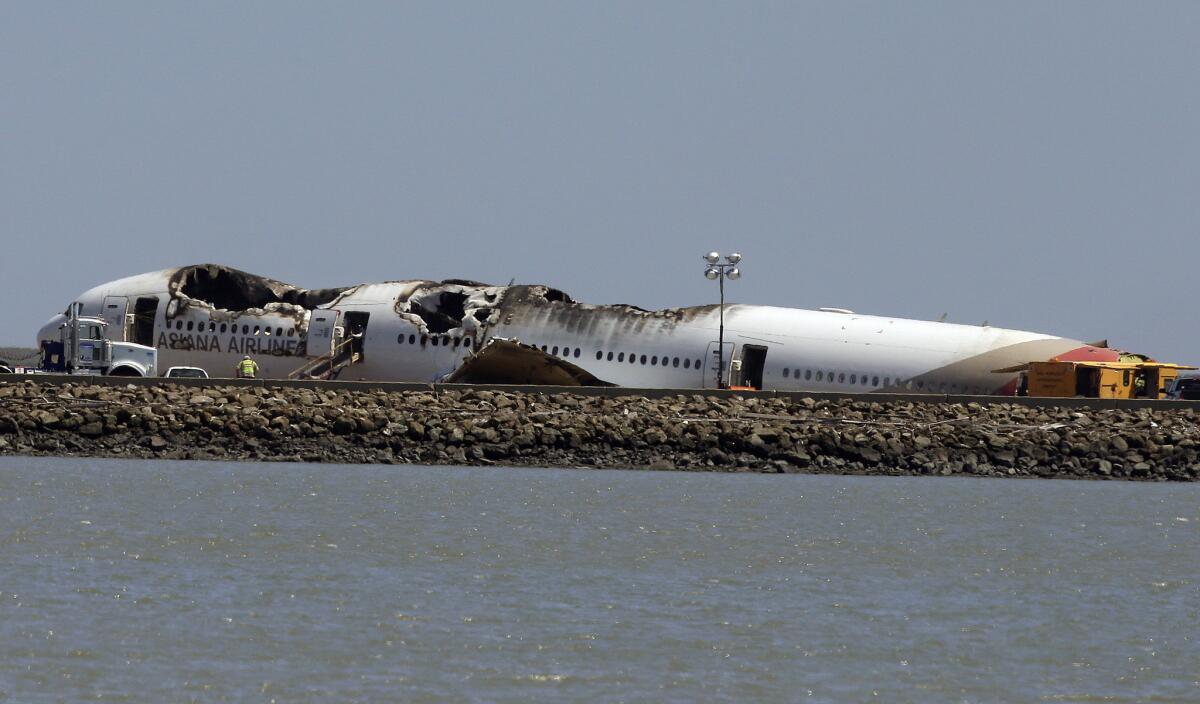Asiana pilots thought plane was automatically controlling speed

- Share via
The pilots of an Asiana Airlines flight that approached its landing at San Francisco International Airport too slow and crashed mistakenly thought the plane was automatically maintaining speed for them, investigators say.
By the time the crew realized their situation moments before the crash Saturday, it was too late. A last-minute attempt to correct the Boeing 777’s flight path failed and the airliner’s tail section smashed into a sea wall, spilling out passengers and crew members.
The new details of the moments inside the cockpit before the crash came to light through interviews National Transportation Safety Board investigators had with the plane’s four pilots, including the trainee who was guiding the plane to the runway.
When the jetliner was 500 feet above the runway, instructional pilot Lee Jung-min told pilot-in-training Lee Kang-kook to pull the plane up, NTSB Chairwoman Deborah Hersman said during a news conference Tuesday.
“They were trying to correct at that point,” Hersman said, citing completed interviews with three of the four pilots.
About 200 feet above the runway, Lee Jung-min said, he saw that all four landing lights on the runway were red -- a sign that the plane was coming in far too low. In the same moment, he said, he noticed that the auto-throttle was not properly regulating the plane’s speed.
Officials said the Asiana jet had fallen more than 30 knots below its target landing speed of 137 knots in the seconds before it crashed, even as the crew desperately tried to apply more engine power. The pilots were given a warning about four seconds before the crash that the aircraft was approaching a stall. At the time of the crash, the engines were running about 50% and increasing in power.
Then the aircraft struck a sea wall at the end of runway 28L, began turning counterclockwise, then went into a full spin, Hersman said. Debris flew onto the runway and into the grass as the aircraft skidded. Two people died in the crash. Scores more were injured.
It was pilot Lee Kang-kook’s first time landing a Boeing 777 at the San Francisco airport, and with a key part of the airport’s automated landing system not working, he was forced to visually guide the massive jetliner onto the runway.
It was the first time he had flown with Lee Jung-min, who was on his first flight as a training supervisor, Hersman said. Lee Jung-min did not call to abort the flight and try again until about 1.5 seconds before the crash, officials have said.
Lee Kang-kook had logged 35 hours on the Boeing 777, about half the hours needed to be certified on the aircraft, Hersman said, citing interviews with the pilot. In total, Lee Kang-kook estimated that he had about 9,700 hours of total flight time, with 5,000 of those as a pilot in command.
When the 777 crashed, three pilots were in the cockpit. Lee Kang-kook was in the left-hand seat, flying; Lee Jung-min was in the right-hand seat, supervising his flight; and a relief first officer was sitting in the jumpseat to monitor the landing. “There is no requirement for four pilots to be in the cockpit,” Hersman said. The relief pilot was sitting in the cabin.
None of the crew was tested for drugs or alcohol after the crash, Hersman said, because foreign flight crews do not fall under the same regulatory requirements as U.S. crews involved in accidents.
Questions remain about the auto-throttle, which helps pilots control the thrust and speed of an aircraft. Although investigators later saw the auto-throttle in the cockpit set to “arm,” that does not necessarily mean they were engaged, Hersman said.
ALSO:
Man plows car through gate at Bob Hope Airport
Man convicted of posing as officer, seeking sex with victim’s wife
Redlands teacher who bore child pleads not guilty to abusing 3 boys
More to Read
Sign up for Essential California
The most important California stories and recommendations in your inbox every morning.
You may occasionally receive promotional content from the Los Angeles Times.














